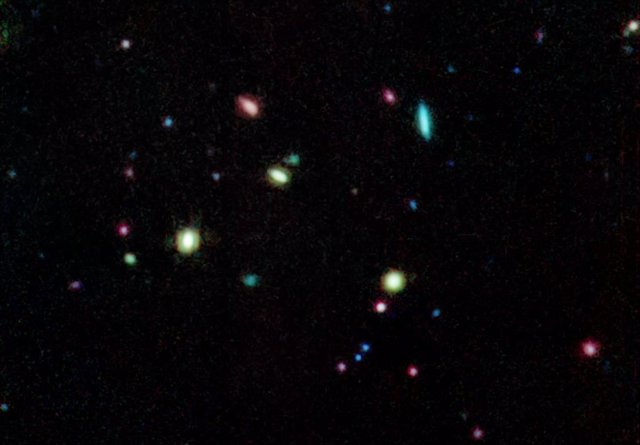Image taken with MIRI, the Medium Infrared Instrument developed by a European consortium in which the Center for Astrobiology (CAB), CSIC-INTA, participated, and installed on the James Webb Space Telescope. -NASA; STSCI; CEERS; CAGR; S. FINKELSTEIN;
Aug. 4 () –
New images from the James Webb Space Telescope show what may be one of the most distant galaxies ever observed. shown as a point of light by its predecessor, Hubble.
They include objects from more than 13,000 million years ago and they offer a much wider field of view than Webb’s first deep-field imagewhich was made public amid great anticipation on July 12.
These are some of the first images obtained within the CEERS project (acronym for the English Cosmic Evolution Early Release Science Survey, a survey with the first scientific results on cosmic evolution), a collaboration that, using the new space telescope, studies how some of the first galaxies formed when the universe was less than 5% of its current ageduring a period known as reionization.
Made up of 18 co-investigators from 12 institutions, including Pablo G. Pérez González, from the Center for Astrobiology (CSIC-INTA), CEERS also has more than 100 collaborators from ten other countries.
A) Yes, in the first week of data analysis, the CEERS team identified a particularly interesting object: a galaxy they named ‘Maisie’, after the daughter of project manager Steven Finkelstein. It is estimated that this galaxy existed only 300 million years after the Big Bang, reports the CAB itself in a statement.
The data, which took about 24 hours to collect, is from a patch of sky near the tail of the Big Dipper. This same area of the sky was previously observed by the Hubble Space Telescope, in what is known as the Extended Groth Fringe.
FOR HUBBLE IT WAS A POINT OF LIGHT
“It is amazing to see how what for Hubble was a point of light now for Webb becomes a complete galaxy with beautiful structures. Not only that, other galaxies pop up out of nowhere!” says Finkelstein, associate professor of astronomy at the University of Texas at Austin and principal investigator for CEERS.

The extremely sharp CEERS images have not only been used to discover distant galaxies, they also show numerous interesting and beautiful objectsrevealing the complexity of the evolution of galaxies throughout the life of the universe: some galaxies look like elegant windmills, others are like small beings at the beginning of their lives, other galaxies show interactions with their neighbors that deform or even destroy them, and others are distributed in the sky as if it were a Pac-Man.
THE IMAGE OBTAINED BY MIRI
MIRI is an instrument that works in the mid-infrared range and was developed by a European consortium in which the CAB (CSIC-INTA) participated. It operates at a much higher spatial resolution than previous mid-infrared telescopes.
Compared to NIRcam, MIRI has a smaller field of view, but detects longer wavelengths, allowing the astrophysicist community to see cosmic dust shining from star-forming galaxies and black holes at great distances. as well as seeing the light of the oldest stars in distant galaxies.
“MIRI’s images are impressive”, says Pérez González, “eight times sharper than what we had until now”. The CAB (CSIC-INTA) researcher, an expert in the study of the evolution of galaxies at different cosmological distances with infrared data, comments that “in each great astrophysical mission that begins, the universe surprises us. We always think that we are already getting so close from the Big Bang that the galaxies must be very young and we should almost detect the first, but JWST is revealing to us very large galaxies already quite evolved when the universe was only 5% of its current age. The universe has been super efficient for most of its life at forming galaxies! Not only that, but also complex chemical elements and compounds, which must have an effect on the appearance of life.”
The CEERS program consists of more than 60 hours of telescope time, almost half of which has been completed so far. In December the program will be completed, adding much more imaging data along with spectroscopic measurements of hundreds of distant galaxies.
















Add Comment